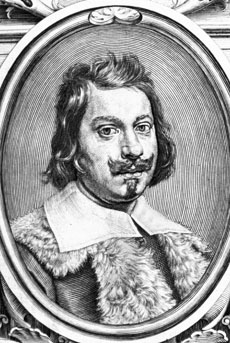| Evangelista Torricelli  Born: 15-Oct-1608 Born: 15-Oct-1608
Birthplace: Faenza, Romagna, Italy
Died: 25-Oct-1647
Location of death: Florence, Italy
Cause of death: Typhus
Gender: Male
Race or Ethnicity: White
Occupation: Mathematician, Scientist Nationality: Italy
Executive summary: Inventor of the barometer Italian physicist and mathematician, born at Faenza on the 15th of October 1608. Left fatherless at an early age, he was educated under the care of his uncle, a Camaldolese monk, who in 1627 sent him to Rome to study science under the Benedictine Benedetto Castelli (1577-1644), professor of mathematics at the Collegio di Sapienza. The perusal of Galileo's Dialoghi delle nuove scienze (1638) inspired him with many developments of the mechanical principles there set forth, which he embodied in a treatise De motu (printed amongst his Opera geometrica, 1644). Its communication by Castelli to Galileo in 1641, with a proposal that Torricelli should reside with him, led to Torricelli repairing to Florence, where he met Galileo, and acted as his amanuensis during the three remaining months of his life. After Galileo's death Torricelli was nominated grand-ducal mathematician and professor of mathematics in the Florentine academy. The discovery of the principle of the barometer which has perpetuated his fame ("Torricellian tube", "Torricellian vacuum") was made in 1643.
The publication amongst Torricelli's Opera geometrica (Florence, 1644) of a tract on the properties of the cycloid involved him in a controversy with Gilles Personne de Roberval, who accused him of plagiarizing his earlier solution of the problem of its quadrature. There seems, however, no room for doubt that Torricelli's was arrived at independently. The matter was still in debate when he was seized with pleurisy, and died at Florence on the 25th of October 1647. He was buried in San Lorenzo, and a commemorative statue of him erected at Faenza in 1864.
Among the new truths detected by him was the valuable mechanical principle that if any number of bodies be so connected that, by their motion, their center of gravity can neither ascend nor descend, then those bodies are in equilibrium. He also discovered the remarkable fact that the parabolas described (in a vacuum) by indefinitely numerous projectiles discharged from the same point with equal velocities, but in all directions have a paraboloid of revolution for their envelope. His theorem that a fluid issues from a small orifice with the same velocity (friction and atmospheric resistance being neglected) which it would have acquired in falling through the depth from its surface is of fundamental importance in hydraulics. He greatly improved both the telescope and microscope. Several large object lenses, engraved with his name, are preserved at Florence. He used and developed B. Cavalieri's method of indivisibles.
A selection from Torricelli's manuscripts was published by Tommaso Bonaventura in 1715, with the title Lezioni accademiche (Florence). They include an address of acknowledgment on his admission to the Accademia della Crusca. His essay on the inundations of the Val di Chiana was printed in Raccolta d'autori che trattano del moto dell' acque, IV. 115 (Florence, 1768), and amongst Opusculi idraulici, III. 347 (Bologna, 1822).
University: Collegio della Sapienza, Pisa
Professor: Professor of Mathematics, Florentine Academy
Author of books:
Opera geometrica (1644, mathematics, includes De Motu)
Do you know something we don't?
Submit a correction or make a comment about this profile
Copyright ©2019 Soylent Communications
|